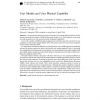Free Online Productivity Tools
i2Speak
i2Symbol
i2OCR
iTex2Img
iWeb2Print
iWeb2Shot
i2Type
iPdf2Split
iPdf2Merge
i2Bopomofo
i2Arabic
i2Style
i2Image
i2PDF
iLatex2Rtf
Sci2ools
UMUAI
2002
2002
User Models and User Physical Capability
Current interface design practices are based on user models and descriptions derived almost exclusively from studies of able-bodied users (Keates et al., 1999). However, such users are only one point on a wide and varied scale of physical capabilities. Users with a number of different physical impairment conditions have the same desire to use computers as able-bodied people (Busby, 1997), but cannot cope with most current computer access systems (Edwards, 1995). It is important to identify the differences in interaction for users of differing physical capability, because the border between the labels `able-bodied' and `motion-impaired' users is becoming increasinglyblurred as the generation ofcomputer users inexorablybecomes older and physically less capable. If user models are to retain their relevance, then they have to be able to re
| Added | 23 Dec 2010 |
| Updated | 23 Dec 2010 |
| Type | Journal |
| Year | 2002 |
| Where | UMUAI |
| Authors | Simeon Keates, Patrick Langdon, P. John Clarkson, Peter Robinson |
Comments (0)

